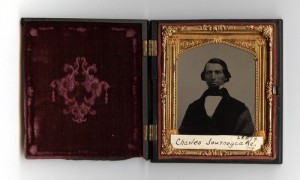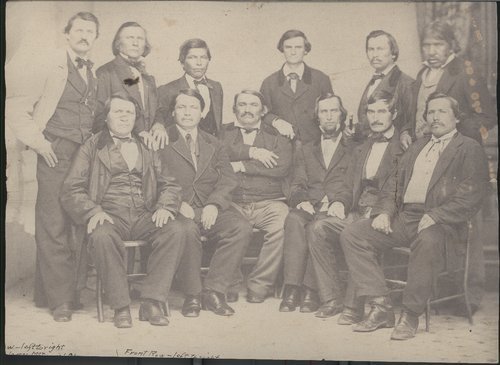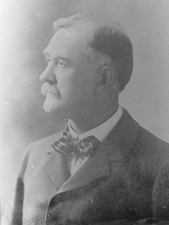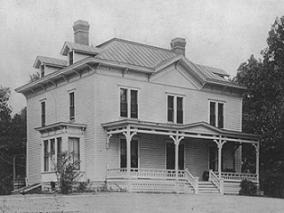Linwood’s History
Researching Linwood
The library is an excellent location to begin your research. We have files on many families and things associated with Linwood and the surrounding area.

We now have an online database where you can search obituaries for people associated with Linwood and the surrounding areas. These files, and more, can also be looked through in a non-digital format inside the library.
LINWOOD HISTORY
Below is a brief introduction to the history of Linwood and the area. Additional information can be found inside the library.
- Charles Journeycake
- The Railroad
- The Floods
- Further Research

CHARLES JOURNEYCAKE (1817 – 1894)
Linwood was founded as “Journeycake,” being named after Charles Journeycake, the last Lenape Delaware chief. Also a Baptist minister, Journeycake (Chief Ne-sha-pa-na-cumin), who was of Delaware, French, and Wyandotte descent, was born on December 16, 1817. His parents, Sally Williams and Delaware chief Solomon Journeycake, lived on Ohio’s Upper Sandusky River, where Charles and his siblings were born. Sally Williams’s mother was a white captive who had married Abraham Williams, a one-half Wyandotte.

Standing left to right: James McDaniel, a Cherokee present at discussions, Black Beaver, interpreter Henry Tiblow, Agent John G. Pratt, Charles Armstrong, and John Young.
In May 1860, a treaty was signed at Sarcoxieville, 3 miles (4.8 km) northeast of Linwood, by Chief Sarcoxie of the Delaware and by the United States. After the signing, each member of the tribe was assigned a parcel of land, and the balance of the tribe’s territories were sold to the predecessor of the Union Pacific Railroad. Meanwhile, the U.S. government established a trading post near Stranger Creek until the tribe was moved to the Indian Territory in 1867.
THE UNION PACIFIC
In September 1863, the Eastern Division of Union Pacific began building the main line westward across the Great Plains from Kansas City, Kansas to Denver, Colorado. This was the long-line railroad in Kansas for 2–3 years. The first 40 miles (64 km) was opened in 1864 from Wyandotte (now a suburb of Kansas City) to Lawrence. Shortly thereafter, a man named William A. Harris moved to Kansas and became employed as a civil engineer for UP. In August of 1870, the railway became known as the Kansas Pacific Railroad before merging with Union Pacific permanently in 1880.
The name change
The original town of Journeycake was officially platted as the town of “Stranger” on July 11, 1867, and established in the records of the Leavenworth County Courthouse. However, the name Stranger posed a problem for postal service workers, who confused Stranger with a nearby town also named Stranger (now Stranger Township, east of Linwood). The town was accordingly renamed on December 20, 1877. Legend has it that one day the townspeople were cutting wood for the church, when Colonel William W. Loring suggested they change the name to Linwood, after the many linden trees that grew in the area. This story is almost certainly apocryphal, as Loring was in Egypt until at least 1878. It is most likely that the town of Stranger had its name changed to Linwood by Senator William A. Harris because of his great appreciation for the trees.
Senator William A. Harris, 1841 – 1909

William A. Harris moved to Kansas in 1865, and worked as a civil engineer for the Union Pacific Railroad until 1868. In that year, he moved to Lawrence, Kansas and was appointed as a bargaining agent for the railroad companies in the sale of the Delaware Reservation and other lands. In 1884, Harris moved to Linwood, quickly becoming a prominent citizen. He engaged in agricultural pursuits and raised livestock. He bought several hundred acres of land on the western edge of Linwood. On a high hill, within sight of town, he built a modest two story mansion with fifteen rooms, later known as the Harris House. Harris was elected as a Democrat to the Fifty-third Congress (1893–1895) and as a Populist in 1897. He was an unsuccessful candidate for Governor of Kansas in 1906. Harris died in 1909, and is buried in Lawrence, Kansas.

THE FLOODS
Although there were many floods in Linwood, two floods in the first decade of the twentieth century stand out as the most destructive. The first occurred during the evening of May 29, 1903. Those who were able moved quickly to higher ground, but there were many Linwood residents who could not move their belongings, and saw their homes and possessions buried in several feet of water.
Most of the Old Linwood town was located in the middle of the floodplain, so the town had to be rebuilt in a new location, slightly west of the original development. Since the old Linwood was always undergoing flood warnings, most residents decided to move into the new town. The City Hall was also moved to the new location after the flood of 1903. However, much of Linwood’s commerce came from the saw mills on the Kansas River, so some people decided to remain in the old part of the village. These residents suffered again during the second great flood, in 1908, but the “Old Linwood” nevertheless persevered.
Now, the City of Linwood encompasses both settlements. The division between the old town of Linwood and the new town is at Bowen Street. Any roads east of Bowen street are the old town of Linwood.
OTHER RESOURCES AND FURTHER RESEARCH
History of Leavenworth County
The full text of a 1921 book describing the history of Leavenworth County to that point. At over 600 pages, it’s one of the most detailed accounts of a single Kansas county that you’ll ever read. Authors: Leroy Hand and Jesse Hall
The Kansas Guide
The Kansas Guide is a community resource website providing information on cities, towns, counties and villages in Kansas. A lot of the information and resources on this website regards Johnson County, though rural areas that are relatively close to Johnson County (such as Linwood) receive a fair amount of attention too.
The Kansas Historical Society
The Kansas Historical Society provides extensive research tools for Kansas who wish to study the people and places that together form our great state. Though the entire website is worth browsing, here are a few pages of particular interest:
- The Kansas Historical QuarterlyThe Kansas Historical Quarterly was published by the KHS from 1931 to 1977. Their website contains advanced search options that will allow you to look for specific articles mentioning Linwood or Leavenworth County.
- Leavenworth County Records on MicrofilmThough these microfilms are not available online, you can request to pick them up here at the Linwood Community Library via InterLibrary Loan. Historical newspapers are also available on microfilm. Unfortunately, we do not have a microfilm reader at the LCL, so you will need to find your own reader.
- Kansas PlacesThis search engine provides assistance in locating historical records regarding rural counties, townships, cemeteries, and other similar locations.
State Library History Portal
This database contains the widest variety of accessible historical content about Kansas and Leavenworth County. Access requires a State Library Card, which you can set up so long as you have a Linwood library card.
The Delaware Indians in Kansas
An account of the role of the Delaware (Lenape) Indians in the founding of Linwood. You can also use the website to find out if any of your ancestors were involved in the formation of the town.
Territorial Kansas Online
Territorial Kansas Online tracks and catalogs resources pertaining to Kansas’s pre-state existence. Since most of the records regard events dating before 1861, the site contains little about Linwood per se, but does provide a full picture of early settlement in Leavenworth County.
If you have any historical facts documented or in photographs and would like to share them here, please email: linwoodlib@linwoodlibrary.org
